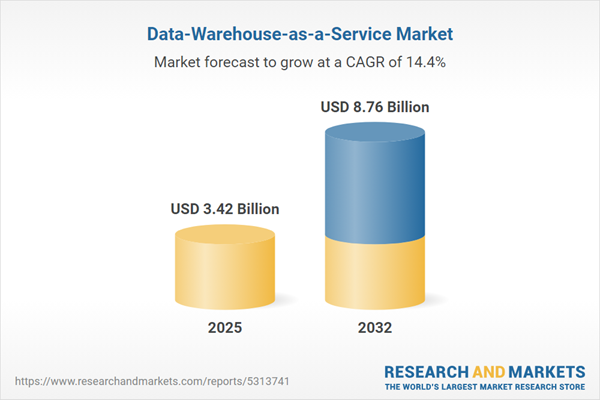Speak directly to the analyst to clarify any post sales queries you may have.
Data Warehouse-as-a-Service (DWaaS) is quickly becoming a cornerstone for enterprises seeking to modernize their analytics, streamline operations, and deliver real-time business intelligence. As organizations move to cloud-native architectures to manage their increasing data complexity, the market is undergoing significant innovation, creating new opportunities for digital transformation.
Market Snapshot: Data Warehouse-as-a-Service Market Overview
The global Data Warehouse-as-a-Service market is demonstrating robust momentum, growing from USD 2.99 billion in 2024 to USD 3.42 billion in 2025. With a compound annual growth rate (CAGR) of 14.36%, the market is forecast to achieve USD 8.76 billion by 2032. This growth is fueled by accelerating adoption of scalable analytics solutions across industries, combined with the need for agile, cost-effective data management models that transcend the limitations of traditional on-premises setups.
Scope & Segmentation
- Service Types: Platform as a Service, Software as a Service.
- Organization Sizes: Large Enterprises, Small and Medium Enterprises.
- Deployment Modes: Hybrid Cloud, Private Cloud, Public Cloud.
- End User Industries: Banking Financial Services and Insurance, Government and Public Sector, Healthcare and Life Sciences, Information Technology and Telecommunication, Manufacturing, Retail and E-commerce.
- Geographic Coverage: Americas (United States, Canada, Mexico, Brazil, Argentina, Chile, Colombia, Peru), Europe, Middle East & Africa (United Kingdom, Germany, France, Russia, Italy, Spain, Netherlands, Sweden, Poland, Switzerland, United Arab Emirates, Saudi Arabia, Qatar, Turkey, Israel, South Africa, Nigeria, Egypt, Kenya), Asia-Pacific (China, India, Japan, Australia, South Korea, Indonesia, Thailand, Malaysia, Singapore, Taiwan).
- Leading Companies: Amazon Web Services, Inc., Microsoft Corporation, Google LLC by Alphabet Inc., Snowflake Inc., Oracle Corporation, International Business Machines Corporation, Alibaba Cloud Computing Ltd., SAP SE, Teradata Corporation, Cloudera, Inc.
Key Takeaways for Senior Decision-Makers
- The shift to Data Warehouse-as-a-Service empowers organizations to dynamically scale analytics capabilities while minimizing infrastructure management.
- Integration of artificial intelligence and machine learning within managed services enables advanced analytics and real-time data transformation.
- Hybrid and multi-cloud deployments reflect a trend toward balancing control, compliance, and scalability for tailored business requirements.
- Industries such as financial services and healthcare are leveraging robust security and regulatory features to ensure data integrity and compliance.
- Partnerships between cloud providers and analytics vendors produce unified data platforms, facilitating seamless integration across the data pipeline.
Tariff Impact: Navigating Recent U.S. Trade Measures
The implementation of new United States tariffs in 2025 is reshaping the cost structures and supply chains that underpin Data Warehouse-as-a-Service. Increased duties on components, including computing processors and networking equipment, have prompted service providers to diversify their sourcing strategies and explore manufacturing locations outside tariff-affected regions. This response focuses on controlling costs and strengthening supply chain resilience amid global trade volatility. Users are also adjusting workload scheduling and service tier utilization to offset pricing pressures brought by rising operational expenses.
Methodology & Data Sources
This market research integrates qualitative and quantitative approaches to deliver comprehensive and actionable insights. Quantitative analysis draws on regulatory filings, public disclosures, industry reports, and proprietary cloud infrastructure datasets. Qualitative input includes interviews with industry executives, solution architects, and market analysts. Cross-validation of findings ensures reliability for strategic planning purposes.
Why This Report Matters
- Enables data-driven decision-making by elucidating technology trends, competitive dynamics, and regional opportunities.
- Supports strategic investment with segmented insights into service models, deployment preferences, and end user priorities.
- Advises on risk mitigation and compliance initiatives, especially amid evolving tariff landscapes and regional regulations.
Conclusion
Data Warehouse-as-a-Service continues to transform enterprise data strategies through cloud-native innovation and adaptive service models. With a focus on operational flexibility and secure, scalable analytics, organizations are positioned to enhance business intelligence capabilities and drive long-term value in a competitive global market.
Additional Product Information:
- Purchase of this report includes 1 year online access with quarterly updates.
- This report can be updated on request. Please contact our Customer Experience team using the Ask a Question widget on our website.
Table of Contents
3. Executive Summary
4. Market Overview
7. Cumulative Impact of Artificial Intelligence 2025
Companies Mentioned
The companies profiled in this Data-Warehouse-as-a-Service market report include:- Amazon Web Services, Inc.
- Microsoft Corporation
- Google LLC by Alphabet Inc.
- Snowflake Inc.
- Oracle Corporation
- International Business Machines Corporation
- Alibaba Cloud Computing Ltd.
- SAP SE
- Teradata Corporation
- Cloudera, Inc.
Table Information
| Report Attribute | Details |
|---|---|
| No. of Pages | 186 |
| Published | November 2025 |
| Forecast Period | 2025 - 2032 |
| Estimated Market Value ( USD | $ 3.42 Billion |
| Forecasted Market Value ( USD | $ 8.76 Billion |
| Compound Annual Growth Rate | 14.3% |
| Regions Covered | Global |
| No. of Companies Mentioned | 11 |









